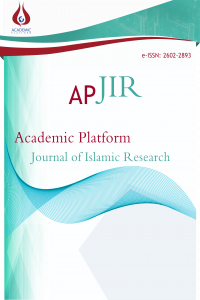A Lost Legendary Humane Common Properties Called Peace and Coexistence of Homo Muslimus in Jerusalem
Jerusalem, homo Muslimus, peace and coexistence, philosophico-sociological holistic and reductiveapproaches, imagology
A Lost Legendary Humane Common Properties Called Peace and Coexistence of Homo Muslimus in Jerusalem
Jerusalem, homo Muslimus, peace and coexistence, philosophico-sociological holistic and reductiveapproaches,
___
- Acikoz, H. M. (2006)Tevhidi Kozmik Holizm, Şüphe ve Eski Uygarlıklar (Tawhedy Cosmic Holism and Ancient Civilizations). Ankara: Elis, Introduction and Chapter One.
- Acikoz, H. M.(2010) Philosophical Essays –II– .Ankara: Araştırma Yayınları, Related Articles.
- Acikoz, H. M.(2016) İletişim Felsefesine Giriş: İnsani İletişimin Felsefi Temelleri (Introduction to Philosophy of Communication: Humanistic Basics of Philosophical Communication). Gnş. 3. Baskı, Ankara: Elis 92, Preface and Introduction.
- Acikoz, H. M.(2016)A Philosophical Critique of the Origin, the Content and the Function of the Ancient Greek Philosophy and Its Myth as to History of Reason Portery of Homo Sceptikus” in ‘Current Topics in Social Scienses’. Eds: Yaldır etal., Chapter SevenSofia, Bulgaria: St. Kliment Ohridski University Press, pp: 70-97.
- Cline, E. H. (2004) Jerusalem Besieged: From Ancient Canaan to Modern Israel. Michigan: University of Michigan Press, pp: 2-11.
- Ahmad, I. (2016) 21. Asırda Islam Rönesansı (Islamic Renaissance in 21th Century).Translated by Acikoz, H. M., Ankara: Araştırma Yayınları 132, pp.33-89.
- Ekman, P. (1992) Telling Lies: Clues to Deceit in the Marketplace, Politics, and Marriage”, W. W. Norton & Company, New York, London,
- Gunes, H. H. (2017) “Kudüs’ü Yeniden Düşünmek”, Önsöz Yayıncılık, İstanbul.
- Gunes, H. H. (2015) “Kudus’te Bir Vakıf Mahalle: Sekiz Yüzyıllık Megaribe Mahallesi ve Serencamı”, Vakıflar Dergisi (44), pp: 9-35.
- Islamoglu, M. (2014) Hayat Kitabı KUR’AN – Gerekçeli Meal-Tefsir (The Book of Life QUR’AN – Justified Translation-Interpretation). İstanbul: Düşün Yayıncılık, related Surah and Ayath.
- Islamoglu, M. (2016) Tabiat ve Kur’an Ayetleri Işığında Yaratılış ve Evrim (Creation and Evolution in the Light of Nature and Quranic Verses), Istanbul: Düşün Yayınları, Preface and First Chapter.
- Meir, G. (1973) A Land of Our Own” (An Oral Autobiography). ed. by Syrkin, M. New York: Putnam’s Sons, On Peace, pp:239-242.
- Ozbay, O. and Dagıtmac, M. (2017) “Dijital Haçlı Seferleri- (Digital Holy Wars of West)”. Introduction, Motto Yayınları, Istanbul.
- Ozturk, A.(2013) İmajoloji: Yeni Bir Disiplin Denemesi (Imagology: A Trail of New Discipline), 2nd Ed., Ankara: Elis Yayınları, pp: 32-65.
- Ozturk, A.(2014) Medeniyet ve Sosyoloji: İmajoloji Çalışmaları (Imagology Studies: Civilization and Sociology), Ankara: Elis Yayınları, pp: 78-112.
- Ozturk, A. (2011) Kriz Sosyolojisi: Batı Merkezciliğinin Yapısal Sorunları ve Kriz (Sociology of Crises: Structural Problems and Crises of Western Centrality). Istanbul: Dogu Kitapevi.
- TDV Islam Ansiklopedisi, KUDUS(القدس(Maddesi (Islamic Encyclopedia of Turkish Religion Foundation, JARESALEM Article), Yıl (Year): 2002, Cilt (Volume): 26, 5 Bölüm (5 Sections Writen by Five Authors), Sayfalar (Pages):323-338.
- Harman, O. H. (2002) Uç İlahi Dinde de Onemli Bir Yere Sahip Olan ve Kutsal Sayılan Sehir (Holied City and Crucial Place for the Three Divine Religions), Section I, pp: 323-327.
- Avci, C. (2002) Fetihten Haçlı Seferlerine Kadar (After Conquer until Crusaders Attacks), Section II, pp: 327-329.
- Demirkent, I. (2002)Haclılar Donemi (Period of Crusaders), Section III, pp: 329-332.
- Tomar, C. (2002)Memluklular (Mamluqies), Section IV, pp: 332-334.
- El-Aseli, K. C. (2002) Osmanlılar Dönemi ve Sonrası (The Period of Ottomans and Further), Section V, pp:334-338.
- Wikipedia (February 2017) Articles of: Homo sapiens; Human Evolution, Jerusalem; History of Jerusalem; and Abraham.
- Yayın Aralığı: Yılda 3 Sayı
- Başlangıç: 2017
- Yayıncı: Akademik Perspektif Derneği
Jerusalem and Artistic Orientations are a Formative Point of View
Jerusalem in Emile Habibi’s Novel Sextet of the Days
Türk Ve Arap Şiirlerinde Kudüs’e Dâir Ağıt, Umut Ve Direniş
The approaches of "Jerusalem's poem" in Samih Al–Qasim's poetry: "Al–Quds Book" as a model
A Lost Legendary Humane Common Properties Called Peace and Coexistence of Homo Muslimus in Jerusalem
Semiology of El Quds in the Contemporary Arabic Poetry
